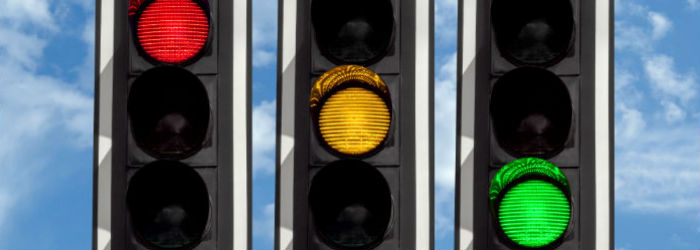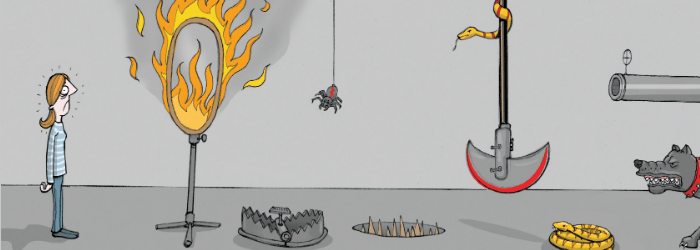Why do we get irritable and angry and what can we do about it?

William Davies, the author of Overcoming Anger and Irritability, explains a useful traffic light exercise for controlling your anger.
Getting angry is a way of letting other people know that what they are doing is going down badly with you. In that case, why should we inhibit our anger? If it fulfils this useful function of informing people when we feel they are they are ‘out of order’, presumably if we inhibit it then everything will go haywire. Other people will trample all over us, secure that there is no payback.
And, if taken to extremes, that would be true. If you were never to show any irritation, never to show any anger, this would probably be confusing for people. They wouldn’t know when you were pleased and when you were displeased; it would be quite disorientating for those who want to please you.
But there is a happy medium. Some people we know are decidedly ‘irritable’. We are not suggesting that they should never show any irritation or anger; that would probably be superhuman (and, as we have just noted, not very helpful). There are things in life that are irritating, things which prompt a ‘normal’ person to show some irritation. When we describe a person as ‘irritable’, however, s/he is going too far, becoming irritated by things that wouldn’t irritate a ‘normal’ person, or getting more irritated than most by slightly irritating things.
So it is not a question of ‘all or nothing’. Yes, it is sometimes just as well for people to be able to sense that we are irritated or angry. On the other hand, it is very easy to take this much too far, to the point where even the slightest thing irritates us, or where we become irritated if things are not exactly as we want them. In that case our irritation and anger mechanism is clearly over-functioning, to the extent that it is counterproductive. When it is functioning at just the right level it provides useful feedback to other people; they can sense when we are slightly irritated and angry with what they are doing and as a result will probably desist. If it is functioning in too extreme a way, those around us get frightened and worried, and our relationships begin to break down.
So how do we perform this difficult balancing act, of keeping any irritation and anger down to useful and beneficial levels – down to those very subtle levels where those around us actually feel pleased to see the very occasional irritation from us, simply because it gives them feedback about what is happening?
For a task as complex as this we need a simple analogy. The best I know is that of traffic lights. If you drive around any reasonably large town you will find there is a complex system of interacting traffic lights. For example, near where I live there is a ring road round which I have to drive to get to the motorway. At one point on this ring road there is a particularly distinctive sequence of lights. The first set normally brings you to a halt; for some reason they usually seem to be on red. While you sit waiting at these lights, you can also see that the second set of lights you have to go through is also on red. In due course your first set turns to green, and you move off. If you go off at a very moderate pace, by the time you reach the second set (which is only 40 or 50 metres away) those too are changing to green and you can sail across, although you do have to keep your wits thoroughly about you during this procedure. The same applies to a third set of lights, again only 40 to 50 metres ahead; these too are in sequence with the first and second sets, and you can time things to get across all three in one steady passage.
In summary, what would be a completely unruly flow of traffic is first of all brought to a halt, then allowed to proceed in a thoroughly orderly and controlled fashion. Of course, there are other roads crossing the road I am on, hence the need for lights. An aerial view of this whole procedure would reveal an amazing number of vehicles, all meshing superbly and proceeding at as reasonable a pace as they possibly can. A real feat of interaction and coordination.
Exactly the same happens when two or more people are interacting. Each individual has their own sense of direction, their own pace they want to keep up, their own interests. At the same time they are very keen to mesh with one another, not only because they know that is to their mutual advantage, but also because it’s enjoyable and satisfying.
So how does the traffic lights analogy work in practice? The main thing is to spot a red light! And that’s easy. As soon as we see any amount of irritation or anger in us, that is a red light. So we don’t just barge across it; that way lies disaster.
When confronted with a red light, irritation and anger in other words, we stop. This is not a ‘give way’ sign; it is very definitely a ‘stop’ one. We really have to make sure we come to a complete halt. Sometimes people say ‘count to ten’. Well, you can do this if you want; certainly it brings things to a pretty marked stop. On the other hand, you can simply note the presence of the ‘red light’ (irritability and anger), carry on talking about whatever you like, and then, when the irritability and anger have subsided to a tiny amount (the lights change to amber, if you like) you can get ready to move on to say or do whatever you think is best.
The traffic lights technique is a remarkably strong and powerful one. But there are several points to be made. Sometimes the ‘red light’ stays on for a very short period of time, barely a second or two. In other cases the red light stays on for hours or even days. Secondly, you don’t always get what you want. And we have to recognise that there’s no law that says we should get what we want, any more than other people always get what they want. There’s no need to ‘awfulise’ this phenomenon. It’s just the way things are.
The third point, and the best news, is that just as we get good at coping with real traffic lights, we also get good at coping with these metaphorical ones.







